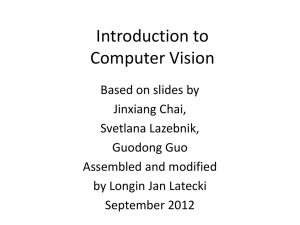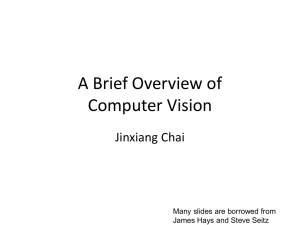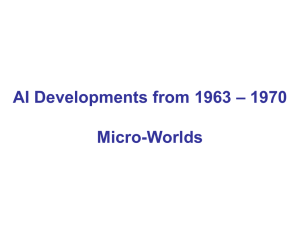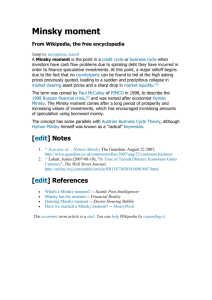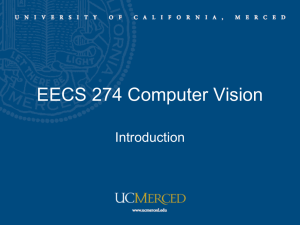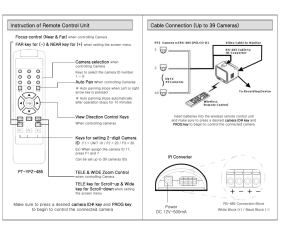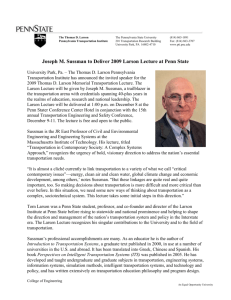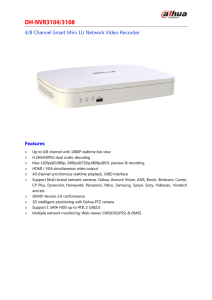Introduction to Computer Vision - TAMU Computer Science Faculty
advertisement
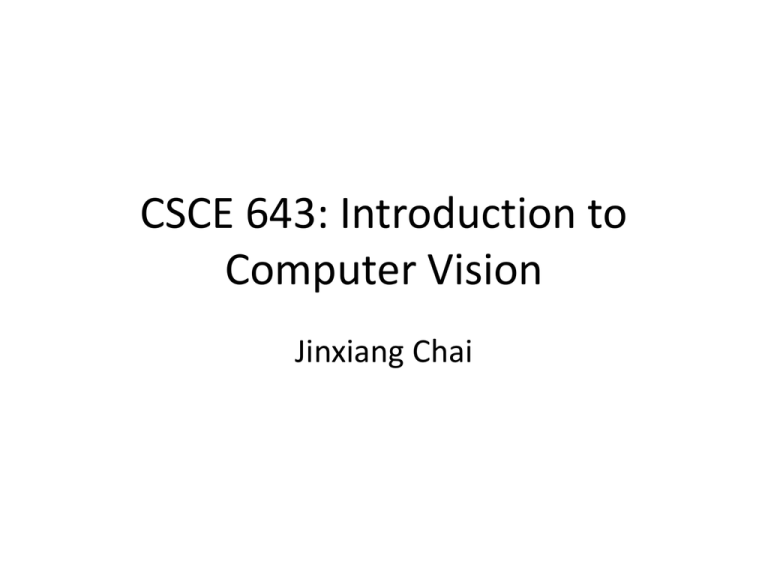
CSCE 643: Introduction to Computer Vision Jinxiang Chai What is Computer Vision? What is Computer Vision? • Computer vision is the science and technology of machines that see. • Concerned with the theory for building artificial systems that obtain information from images. • The image data can take many forms, such as a video sequence, depth images, views from multiple cameras, or multi-dimensional data from a medical scanner Computer Vision Make computers understand images and videos. What kind of scene? Where are the cars? How far is the building? … Components of a computer vision system Camera Lighting Computer Scene Scene Interpretation Srinivasa Narasimhan’s slide Computer vision vs human vision What we see What a computer sees Vision is really hard • Vision is an amazing feat of natural intelligence – Visual cortex occupies about 50% of Macaque brain – More human brain devoted to vision than anything else Is that a queen or a bishop? Vision is multidisciplinary Computer Graphics HCI From wiki Why computer vision matters Safety Health Comfort Fun Security Access A little story about Computer Vision In 1966, Marvin Minsky at MIT asked his undergraduate student Gerald Jay Sussman to “spend the summer linking a camera to a computer and getting the computer to describe what it saw”. We now know that the problem is slightly more difficult than that. (Szeliski 2009, Computer Vision) A little story about Computer Vision Founder, MIT AI project In 1966, Marvin Minsky at MIT asked his undergraduate student Gerald Jay Sussman to “spend the summer linking a camera to a computer and getting the computer to describe what it saw”. We now know that the problem is slightly more difficult than that. A little story about Computer Vision In 1966, Marvin Minsky at MIT asked his undergraduate student Gerald Jay Sussman to “spend the summer linking a camera to a computer and getting the computer to describe what it saw”. We now know that the problem is slightly more difficult than that. Image Understanding Ridiculously brief history of computer vision • 1966: Minsky assigns computer vision as an undergrad summer project • 1960’s: interpretation of synthetic worlds • 1970’s: some progress on interpreting selected images • 1980’s: ANNs come and go; shift toward geometry and increased mathematical rigor • 1990’s: face recognition; statistical analysis in vogue • 2000’s: broader recognition; large annotated datasets available; video processing starts; vision & graphis; vision for HCI; internet vision, etc. Guzman ‘68 Ohta Kanade ‘78 Turk and Pentland ‘91 How vision is used now • Examples of state-of-the-art Optical character recognition (OCR) Technology to convert scanned docs to text • If you have a scanner, it probably came with OCR software Digit recognition, AT&T labs http://www.research.att.com/~yann/ License plate readers http://en.wikipedia.org/wiki/Automatic_number_plate_recognition Face detection • Many new digital cameras now detect faces – Canon, Sony, Fuji, … Smile detection Sony Cyber-shot® T70 Digital Still Camera Object recognition (in supermarkets) LaneHawk by EvolutionRobotics “A smart camera is flush-mounted in the checkout lane, continuously watching for items. When an item is detected and recognized, the cashier verifies the quantity of items that were found under the basket, and continues to close the transaction. The item can remain under the basket, and with LaneHawk,you are assured to get paid for it… “ Vision-based biometrics “How the Afghan Girl was Identified by Her Iris Patterns” Read the story wikipedia Login without a password… Fingerprint scanners on many new laptops, other devices Face recognition systems now beginning to appear more widely http://www.sensiblevision.com/ Object recognition (in mobile phones) Point & Find, Nokia Google Goggles Special effects: shape capture The Matrix movies, ESC Entertainment, XYZRGB, NRC Special effects: motion capture Pirates of the Carribean, Industrial Light and Magic Sports Sportvision first down line Nice explanation on www.howstuffworks.com http://www.sportvision.com/video.html Smart cars Slide content courtesy of Amnon Shashua • Mobileye [wiki article] – Vision systems currently in high-end BMW, GM, Volvo models – By 2010: 70% of car manufacturers. Google cars http://www.nytimes.com/2010/10/10/science/10google.html?ref=artificialintelligence Interactive Games: Kinect • • • • • Object Recognition: http://www.youtube.com/watch?feature=iv&v=fQ59dXOo63o Mario: http://www.youtube.com/watch?v=8CTJL5lUjHg 3D: http://www.youtube.com/watch?v=7QrnwoO1-8A Robot: http://www.youtube.com/watch?v=w8BmgtMKFbY 3D tracking, reconstruction, and interaction: http://research.microsoft.com/enus/projects/surfacerecon/default.aspx Vision in space NASA'S Mars Exploration Rover Spirit captured this westward view from atop a low plateau where Spirit spent the closing months of 2007. Vision systems (JPL) used for several tasks • • • • Panorama stitching 3D terrain modeling Obstacle detection, position tracking For more, read “Computer Vision on Mars” by Matthies et al. Industrial robots Vision-guided robots position nut runners on wheels Mobile robots NASA’s Mars Spirit Rover http://en.wikipedia.org/wiki/Spirit_rover http://www.robocup.org/ Saxena et al. 2008 STAIR at Stanford Medical imaging 3D imaging MRI, CT Image guided surgery Grimson et al., MIT Prerequisites • A good working knowledge of C/C++, Java or Matlab • A good understand of math (linear algebra, basic calculus, basic probability) • Willing to learn new stuffs (optimization, statistical learning etc.) Grading Schemes • Assignments (25%) • Final project (40%+) • Class participation/discussion (5%) • Paper readings and presentation (25%) Final Project Approved by the professor Student can work in a group of two Submit your code and final project report Final presentation & in class demos Late policy: 20% reduction per day if you do not have good reasons Other Information My email: jchai@cs.tamu.edu My homepage: http://faculty.cs.tamu.edu/jchai My office: Rm 527D Bright Office hours: Wed 4:00-5:00 Pm or by appointment Course webpage: http://www.cs.tamu.edu/jchai/csce643/ Textbook: Computer vision: Algorithms and Applications, Richard Szelisk Email Me Today Your background • Vision, Graphics, machine learning, image processing • Math (linear algebra, statistics, calculus, optimization, etc.) • Coding (C++, java, matlab, etc.) Your research Interest? Master/Ph.D. (year)? Why do you take this class?
